In this post we will learn how to read and write JSON files using Python. In the first, part we are going to use the Python package json to create a JSON file and write a JSON file. In the next part we are going to use Pandas json method to load JSON files into Pandas dataframe. Here, we will learn how to read from a JSON file locally and from an URL as well as how to read a nested JSON file using Pandas.
Finally, as a bonus, we will also learn how to manipulate data in Pandas dataframes, rename columns, and plot the data using Seaborn.
What is a JSON File?
JSON, short for JavaScript Object Notation, is a compact, text based format used to exchange data. This format that is common for downloading, and storing, information from web servers via so-called Web APIs. JSON is a text-based format and when opening up a JSON file, we will recognize the structure. That is, it is not so different from Python’s structure for a dictionary.
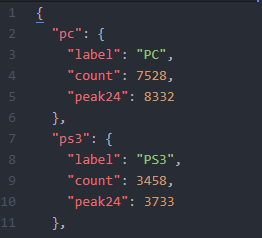 Example JSON file
Example JSON file
In the first example we are going to use the Python module json to create a JSON file. After we’ve done that we are going to load the JSON file. In this Python JSON tutorial, we start by create a dictionary for our data:
import json
data = {"Sub_ID":["1","2","3","4","5","6","7","8" ],
"Name":["Erik", "Daniel", "Michael", "Sven",
"Gary", "Carol","Lisa", "Elisabeth" ],
"Salary":["723.3", "515.2", "621", "731",
"844.15","558", "642.8", "732.5" ],
"StartDate":[ "1/1/2011", "7/23/2013", "12/15/2011",
"6/11/2013", "3/27/2011","5/21/2012",
"7/30/2013", "6/17/2014"],
"Department":[ "IT", "Manegement", "IT", "HR",
"Finance", "IT", "Manegement", "IT"],
"Sex":[ "M", "M", "M",
"M", "M", "F", "F", "F"]}
print(data)
 Python dictionary
Python dictionary
Saving to a JSON file
In Python, there is the module json that enables us read and write content to and from a JSON file. This module converts the JSONs format to Python’s internal format for Data Structures. So we can work with JSON structures just as we do in the usual way with Python’s own data structures.
Python JSON Example:
In the example code below, we start by importing the json module. After we’ve done that, we open up a new file and use the dump method to write a json file using Python.
import json
with open('data.json', 'w') as outfile:
json.dump(data, outfile)
How to Use Pandas to Load a JSON File
Now, if we are going to work with the data we might want to use Pandas to load the JSON file into a Pandas dataframe. This will enable us to manipulate data, do summary statistics, and data visualization using Pandas built-in methods. Note, we will cover this briefly later in this post also.
Pandas Read Json Example:
In the next example we are going to use Pandas read_json method to read the JSON file we wrote earlier (i.e., data.json). It’s fairly simple we start by importing pandas as pd:
import pandas as pd
df = pd.read_json('data.json')
df
The output, when working with Jupyter Notebooks, will look like this:

Data Manipulation using Pandas
Now that we have loaded the JSON file into a Pandas dataframe we are going use Pandas inplace method to modify our dataframe. We start by setting the Sub_ID column as index.
df.set_index('Sub_ID', inplace=True)
df
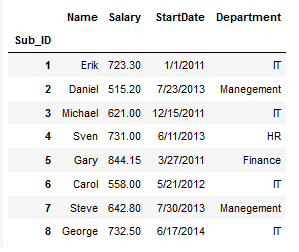
Pandas JSON to CSV Example
Now when we have loaded a JSON file into a dataframe we may want to save it in another format. For instance, we may want to save it as a CSV file and we can do that using Pandas read_csv method. It may be useful to store it in a CSV, if we prefer to browse through the data in a text editor or Excel.
In the Pandas JSON to CSV example below, we carry out the same data manipulation method.
df.to_csv("data.csv")
Learn more about working with CSV files using Pandas in the Pandas Read CSV Tutorial
How to Load JSON from an URL
We have now seen how easy it is to create a JSON file, write it to our hard drive using Python, and, finally, how to read it using Pandas. However, as previously mentioned, many times the data in stored in the JSON format are on the web.
Thus, in this section of the Python json guide, we are going to learn how to use Pandas read_json method to read a JSON file from an URL. Most often, it’s fairly simple we just create a string variable pointing to the URL:
url = "https://api.exchangerate-api.com/v4/latest/USD"
df = pd.read_json(url)
df.head()
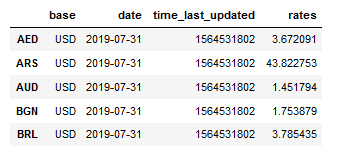
Load JSON from an URL Second Example
When loading some data, using Pandas read_json seems to create a dataframe with dictionaries within each cell. One way to deal with these dictionaries, nested within dictionaries, is to work with the Python module request. This module also have a method for parsing JSON files. After we have parsed the JSON file we will use the method json_normalize to convert the JSON file to a dataframe.
 Pandas Dataframe from JSON
Pandas Dataframe from JSON
import requests
from pandas.io.json import json_normalize
url = "https://think.cs.vt.edu/corgis/json/airlines/airlines.json"
resp = requests.get(url=url)
df = json_normalize(resp.json())
df.head()
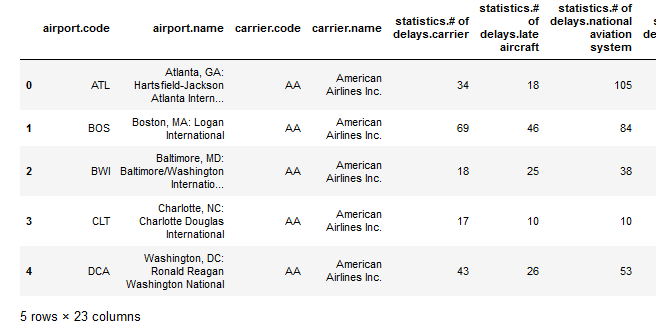
As can be seen in the image above, the column names are quite long. This is quite impractical when we are going to create a time series plot, later, using Seaborn. We are now going to rename the columns so they become a bit easier to use.
In the code example below, we use Pandas rename method together with the Python module re. That is, we are using a regular expression to remove “statistics.# of” and “statistics.” from the column names. Finally, we are also replacing dots (“.”) with underscores (“_”) using the str.replace method:
import re
df.rename(columns=lambda x: re.sub("statistics.# of","",x),
inplace=True)
df.rename(columns=lambda x: re.sub("statistics.","",x),
inplace=True)
df.columns = df.columns.str.replace("[.]", "_")
df.head()
Time Series Plot from JSON Data using Seaborn
In the last example, in this post, we are going to use Seaborn to create a time series plot. The data we loaded from JSON to a dataframe contains data about delayed and canceled flights. We are going to use Seaborns lineplot method to create a time series plot of the number of canceled flights throughout 2003 to 2016, grouped by carrier code.
%matplotlib inline
import matplotlib.pyplot as plt
import seaborn as sns
fig = plt.figure(figsize=(10, 7))
g = sns.lineplot(x="timeyear", y="flightscancelled", ci=False,
hue="carriercode", data=df)
g.set_ylabel("Flights Cancelled",fontsize=20)
g.set_xlabel("Year",fontsize=20)
plt.legend(bbox_to_anchor=(1.05, 1), loc=2, borderaxespad=0.)
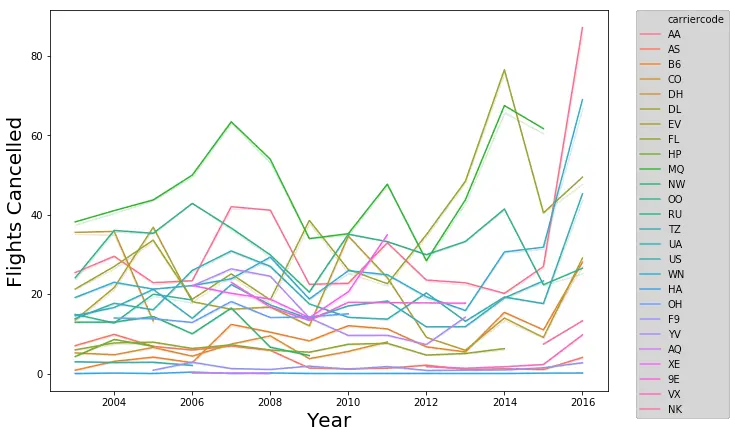
Note, we changed the font size as well as the x- and y-axis’ labels using the methods set_ylabel and set_xlabel. Furthermore, we also moved the legend using the legend method from matplotlib.
For more about exploratory data analysis using Python:
- 9 Data Visualization Techniques That You Should Learn in Python
- Exploratory Data Analysis using Python, Pandas, and Seaborn
Conclusion
In this post we have learned how to write a JSON file from a Python dictionary, how to load that JSON file using Python and Pandas. Furthermore, we have also learned how to use Pandas to load a JSON file from an URL to a dataframe, how to read a nested JSON file to a dataframe.
Here’s a link to a Jupyter Notebook containing all code examples in this post.
The post How to Read and Write JSON Files using Python and Pandas appeared first on Erik Marsja.
from Planet Python
via read more
No comments:
Post a Comment